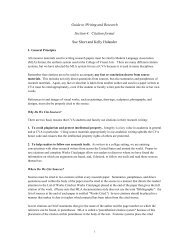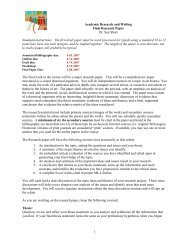Woman with a Fan: Paul Gauguin's Heavenly Vairaumati-a Parable ...
Woman with a Fan: Paul Gauguin's Heavenly Vairaumati-a Parable ...
Woman with a Fan: Paul Gauguin's Heavenly Vairaumati-a Parable ...
Create successful ePaper yourself
Turn your PDF publications into a flip-book with our unique Google optimized e-Paper software.
itial in ihe nmodern world. His summary of the origins and<br />
latc of himankind unfolds in a life cycle from right to left,<br />
wheire a replica of the goddess as depicted in Vairumati sits<br />
next to an old woman, uniting rebirth <strong>with</strong> death. 7 s These<br />
ideas all inforin his renewed interest in <strong>Vairaumati</strong> as a<br />
inctaplhot lot regeneration.<br />
The snllject of <strong>Woman</strong> w/ih a Pan bears a strong resemblance<br />
to that of Vairumali. Although the poses are reversed,<br />
each liguire leans on a fully extended arm, pushing her<br />
shoulder up iunder the thrust of her weight, borne on the<br />
palh of her hand flat against the surface beneath her. Each<br />
perches askew oin an exotic support, her legs to the side,<br />
throwing the burden of her tot-so onto the column of her<br />
armi. Vairatnnati is poised on the edge of an elongated seat<br />
<strong>with</strong> an ornate headboard, not unlike a tombstone, whereas<br />
tme woman <strong>with</strong> a fan is ensconced on a chair <strong>with</strong> a carved<br />
back oddly rcriliniscent of bones, an ossified relic of the<br />
b)eyond.7' Vairauniati's throne, framing her silhouette like a<br />
lialo, is replaced by an aureole of light in <strong>Woman</strong> <strong>with</strong> a <strong>Fan</strong>.<br />
Bloth women emanate a distinctive glow that matches the<br />
dcscriplion of Vairaumnati in Noa Noa: "the fire of the sun<br />
shines ini the gold of her body," 7 5 Next to <strong>Vairaumati</strong>, a white<br />
bird chitiches a green lizard in its claws. Its luminosity delaclies<br />
this winged companion from the fiery background, an<br />
fIfect ecthoed in <strong>Woman</strong> wilh a <strong>Fan</strong> by the intense white<br />
Iatl fes ofl heir fan and drapery against the paler warm colors.<br />
Vaiirauimati appears outdoors, in front of green and yellow<br />
bIushes, accompanied by two seated women, one of whom<br />
bears a pflater of offe ings, whereas the woman <strong>with</strong> a fan is<br />
conspicuously alone. In contrast to the crowded surroundings<br />
of Vairaumnati, the woman <strong>with</strong> a fan is isolated in an<br />
ethereal zorie, where the organic forms hang in symbolic<br />
ratlicr than real space. Neither woman is concerned <strong>with</strong> the<br />
viewer each looks off to the side, conveying a dreamy air.<br />
I lowcwvr, Vairautnati is tied to the earth, in contrast to the<br />
woman <strong>with</strong> a fan, who inhabits a spiritual realm: the timeless<br />
godden ground of Cimabue, so revered by Gauguin. 7 '<br />
The apposition of WoUman <strong>with</strong> a <strong>Fan</strong> to Vairunmati makes it<br />
a plausible oonclusion to the canvases that Gauguin devoted<br />
to "tlhis beloved of the gods."' 77 The radiant serenity and<br />
sovereign moutnentality of the former coincide seamlessly<br />
<strong>with</strong> tlic myth's finale, when <strong>Vairaumati</strong> takes her place<br />
"almiong Ilie deities." iler shroudlike white wrap suits her<br />
passage rotim the terrestrial to the celestial. To emphasize<br />
thtm Vairauminai has shed her earthly bonds, Gauguin may<br />
have norrowed the ancient. Egyptian usage of the fan as an<br />
idcograph for a shade or spirit.7" Her feather fan is arguably<br />
the vcstige of the white bird sacred to Hina, designating<br />
Vairanttti as the vehicle of regeneration decreed by the<br />
mooti god(lcss.<br />
The canvases depicting Vairatutati accunmulate a force that<br />
climaxes <strong>with</strong> <strong>Woman</strong> <strong>with</strong> a <strong>Fan</strong>. The exotic eroticism of the<br />
itortaf's stori that lirst intrigued the artist gave way to his<br />
regard (tI ht Iter role as the vessel of renascence. The pose gives<br />
visual unity Io the figures, while anecdotal accessories progiessivcly<br />
disappear. The changes themselves took on added<br />
significaric folr him as he transformed the mythical subject<br />
ovw(t the years. What had begun as the depiction of a myth<br />
that prolffc'rd an ersatz authenticity for <strong>Gauguin's</strong> Tahitian<br />
project shifted to the mode of a parable of regeneration,<br />
WOMAN WITH A IFAN: PAUL GAIGUIVN'S HEAVENLY VAIRAUMATI 56(1<br />
6 Pierre Puvis de Chavannes, Hope, 1872, oil on canvas, 27'.<br />
X 32Y/ in. Mus& d'Orsav, Paris (artwork in the public<br />
domain; photograph by D. Arnaudet, provided by the Reunion<br />
des Musees Nationaux)<br />
steeped in allusions to his convictions and experiences.<br />
<strong>Woman</strong> <strong>with</strong> a Ean brings closure to the myth by coumnemorating<br />
<strong>Vairaumati</strong>'s immortality through the aesthetic of<br />
transposition.<br />
Hope by Puvis de Chavannes<br />
The parallel between <strong>Gauguin's</strong> figures of <strong>Vairaumati</strong> and<br />
that of Hope in the painting of that name by Puvis de<br />
Chavannes (Fig. 6) introduces another dimension to the<br />
metaphor of transposition invested in W4oman With a <strong>Fan</strong>.79 As<br />
the accepted prototype for the pose of Vairauniati, Hope<br />
reinforces the metaphysical ties among <strong>Gauguin's</strong> different<br />
versions. Gauguin held an abiding admiration for Puvis de<br />
Chavannes, whose work imparted an ineffable aura of mystery<br />
that Gauguin emulated. Although the two men differed<br />
greatly, both in terms of their personalities and their art,<br />
Puvis exerted a persistent influence on his younger colleague.<br />
This could take the form of specific links between<br />
compositions or in the more subtle ways that Gauguin manipulated<br />
or repudiated the other's symbolism as a foil. His<br />
penchant for the decorative found reinforcement in the<br />
older man's art, <strong>with</strong> his similar taste for the primitive, rendered<br />
<strong>with</strong> flat, matte surfaces. Puvis's murals lent their measure<br />
of scope and scale to Mhere Do 11c Come P'rom?""<br />
In the nude version of Hope, the maiden, turned toward the<br />
viewer, her legs to the side, occupies a flowery mound. She<br />
leans on her right hand, extending an oak branch in her left.<br />
Behind her can be seen a castle in ruins and a field of crosses<br />
marking the graves of soldiers, a scene of hibernal desolation.<br />
Her youthful innocence and purity against a backdrop of<br />
destruction and death signify rebirth, the rites of spring. The<br />
hope in question refers to the ardent desire of the French to<br />
see the nation's prestige restored after the Franco-Prussian<br />
War-the war that deprived them of the provinces of Alsace<br />
and Lorraine, as Gauguin notes in Racontars de rapin.I 1





